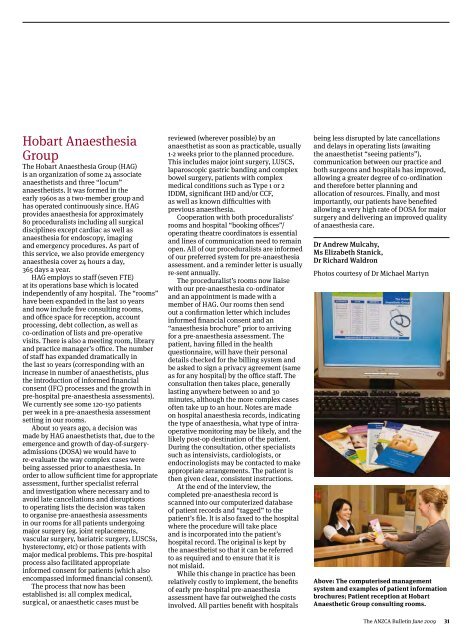ANZCA Bulletin - June 2009 - Australian and New Zealand College ...
ANZCA Bulletin - June 2009 - Australian and New Zealand College ...
ANZCA Bulletin - June 2009 - Australian and New Zealand College ...
- No tags were found...
You also want an ePaper? Increase the reach of your titles
YUMPU automatically turns print PDFs into web optimized ePapers that Google loves.
Hobart AnaesthesiaGroupThe Hobart Anaesthesia Group (HAG)is an organization of some 24 associateanaesthetists <strong>and</strong> three “locum”anaesthetists. It was formed in theearly 1960s as a two-member group <strong>and</strong>has operated continuously since. HAGprovides anaesthesia for approximately80 proceduralists including all surgicaldisciplines except cardiac as well asanaesthesia for endoscopy, imaging<strong>and</strong> emergency procedures. As part ofthis service, we also provide emergencyanaesthesia cover 24 hours a day,365 days a year.HAG employs 10 staff (seven FTE)at its operations base which is locatedindependently of any hospital. The “rooms”have been exp<strong>and</strong>ed in the last 10 years<strong>and</strong> now include five consulting rooms,<strong>and</strong> office space for reception, accountprocessing, debt collection, as well asco-ordination of lists <strong>and</strong> pre-operativevisits. There is also a meeting room, library<strong>and</strong> practice manager’s office. The numberof staff has exp<strong>and</strong>ed dramatically inthe last 10 years (corresponding with anincrease in number of anaesthetists, plusthe introduction of informed financialconsent (IFC) processes <strong>and</strong> the growth inpre-hospital pre-anaesthesia assessments).We currently see some 120-150 patientsper week in a pre-anaesthesia assessmentsetting in our rooms.About 10 years ago, a decision wasmade by HAG anaesthetists that, due to theemergence <strong>and</strong> growth of day-of-surgeryadmissions(DOSA) we would have tore-evaluate the way complex cases werebeing assessed prior to anaesthesia. Inorder to allow sufficient time for appropriateassessment, further specialist referral<strong>and</strong> investigation where necessary <strong>and</strong> toavoid late cancellations <strong>and</strong> disruptionsto operating lists the decision was takento organise pre-anaesthesia assessmentsin our rooms for all patients undergoingmajor surgery (eg. joint replacements,vascular surgery, bariatric surgery, LUSCSs,hysterectomy, etc) or those patients withmajor medical problems. This pre-hospitalprocess also facilitated appropriateinformed consent for patients (which alsoencompassed informed financial consent).The process that now has beenestablished is: all complex medical,surgical, or anaesthetic cases must bereviewed (wherever possible) by ananaesthetist as soon as practicable, usually1-2 weeks prior to the planned procedure.This includes major joint surgery, LUSCS,laparoscopic gastric b<strong>and</strong>ing <strong>and</strong> complexbowel surgery, patients with complexmedical conditions such as Type 1 or 2IDDM, significant IHD <strong>and</strong>/or CCF,as well as known difficulties withprevious anaesthesia.Cooperation with both proceduralists’rooms <strong>and</strong> hospital “booking offices”/operating theatre coordinators is essential<strong>and</strong> lines of communication need to remainopen. All of our proceduralists are informedof our preferred system for pre-anaesthesiaassessment. <strong>and</strong> a reminder letter is usuallyre-sent annually.The proceduralist’s rooms now liaisewith our pre-anaesthesia co-ordinator<strong>and</strong> an appointment is made with amember of HAG. Our rooms then sendout a confirmation letter which includesinformed financial consent <strong>and</strong> an“anaesthesia brochure” prior to arrivingfor a pre-anaesthesia assessment. Thepatient, having filled in the healthquestionnaire, will have their personaldetails checked for the billing system <strong>and</strong>be asked to sign a privacy agreement (sameas for any hospital) by the office staff. Theconsultation then takes place, generallylasting anywhere between 10 <strong>and</strong> 30minutes, although the more complex casesoften take up to an hour. Notes are madeon hospital anaesthesia records, indicatingthe type of anaesthesia, what type of intraoperativemonitoring may be likely, <strong>and</strong> thelikely post-op destination of the patient.During the consultation, other specialistssuch as intensivists, cardiologists, orendocrinologists may be contacted to makeappropriate arrangements. The patient isthen given clear, consistent instructions.At the end of the interview, thecompleted pre-anaesthesia record isscanned into our computerized databaseof patient records <strong>and</strong> “tagged” to thepatient’s file. It is also faxed to the hospitalwhere the procedure will take place<strong>and</strong> is incorporated into the patient’shospital record. The original is kept bythe anaesthetist so that it can be referredto as required <strong>and</strong> to ensure that it isnot mislaid.While this change in practice has beenrelatively costly to implement, the benefitsof early pre-hospital pre-anaesthesiaassessment have far outweighed the costsinvolved. All parties benefit with hospitalsbeing less disrupted by late cancellations<strong>and</strong> delays in operating lists (awaitingthe anaesthetist “seeing patients”),communication between our practice <strong>and</strong>both surgeons <strong>and</strong> hospitals has improved,allowing a greater degree of co-ordination<strong>and</strong> therefore better planning <strong>and</strong>allocation of resources. Finally, <strong>and</strong> mostimportantly, our patients have benefitedallowing a very high rate of DOSA for majorsurgery <strong>and</strong> delivering an improved qualityof anaesthesia care.Dr Andrew Mulcahy,Ms Elizabeth Stanick,Dr Richard WaldronPhotos courtesy of Dr Michael MartynAbove: The computerised managementsystem <strong>and</strong> examples of patient informationbrochures; Patient reception at HobartAnaesthetic Group consulting rooms.The <strong>ANZCA</strong> <strong>Bulletin</strong> <strong>June</strong> <strong>2009</strong> 31
















